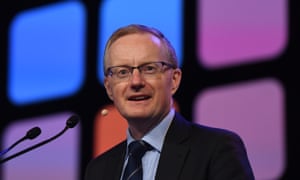RBA governor Philip Lowe says low wages growth could keep Australia from reaching the target of 2.5% inflation
Australia could become mired in a low-wage, low-inflation environment
if incomes keep growing at near record-low levels, the Reserve Bank
governor has warned.
In a speech that will dampen expectations of strong wages growth in coming years, RBA governor Philip Lowe said he was still trying to figure out why countries such as Australia were not experiencing the traditional increase in wages growth in response to tightening labour markets.
He said he still believed wages could eventually start growing at an annual rate of 3% again, rather than the current low of 2%, but it will be a process that could take years.
“We are still trying to understand fully why things look different in so many countries and how persistent it will be,” he told the Australian Industry Group on Wednesday.
“Part of the story is likely to be changes in the bargaining power of workers and an increase in the supply of workers as the global economy becomes more integrated.
“But another important part of the story lies in the nature of recent technological progress … the benefits of new technologies are accruing unevenly across the community.”
In April, Lowe had told a business audience in Western Australia that the economy’s painful run of record low wages growth may have finally troughed, and that wages could be expected to grow more quickly from this point.
But on Wednesday he cautioned that the process could take time.
He said persistently slow wages growth was contributing to persistently weak inflation, and if wages growth remained near its current rate for an “extended period”, the rate of inflation could fail to average at the midpoint of the RBA’s target in coming year.
In a speech that will dampen expectations of strong wages growth in coming years, RBA governor Philip Lowe said he was still trying to figure out why countries such as Australia were not experiencing the traditional increase in wages growth in response to tightening labour markets.
He said he still believed wages could eventually start growing at an annual rate of 3% again, rather than the current low of 2%, but it will be a process that could take years.
“We are still trying to understand fully why things look different in so many countries and how persistent it will be,” he told the Australian Industry Group on Wednesday.
“Part of the story is likely to be changes in the bargaining power of workers and an increase in the supply of workers as the global economy becomes more integrated.
“But another important part of the story lies in the nature of recent technological progress … the benefits of new technologies are accruing unevenly across the community.”
In April, Lowe had told a business audience in Western Australia that the economy’s painful run of record low wages growth may have finally troughed, and that wages could be expected to grow more quickly from this point.
But on Wednesday he cautioned that the process could take time.
He said persistently slow wages growth was contributing to persistently weak inflation, and if wages growth remained near its current rate for an “extended period”, the rate of inflation could fail to average at the midpoint of the RBA’s target in coming year.
“Some pick-up in wages growth would be a welcome development. It would help deliver a rate of inflation consistent with the target, it would help with the debt situation and it would add to our sense of shared prosperity.
“[But] this pick-up is expected to be only gradual given both the spare capacity that still exists in our labour market and the structural factors at work,” he said.
Given the difficult task of fully understanding current wage dynamics, Lowe said Australia needed to focus on lifting education and research levels, and improving worker-related training, because that was historically a way to boost productivity.
“Ultimately, the basis for sustained growth in real wages is that we become more productive as a nation,” he said.
“The recent productivity data are difficult to interpret. Despite a positive outcome in the most recent quarter, there has been no net increase in measured labour productivity over the past two years.”
Lowe said the design of the tax system, the provision and pricing of infrastructure, and Australian business culture around innovation were also important elements in the productivity debate.
“We need to keep all these areas on the radars of both government and business if we are to build on the current prosperity that we currently enjoy,” he said.

No comments:
Post a Comment